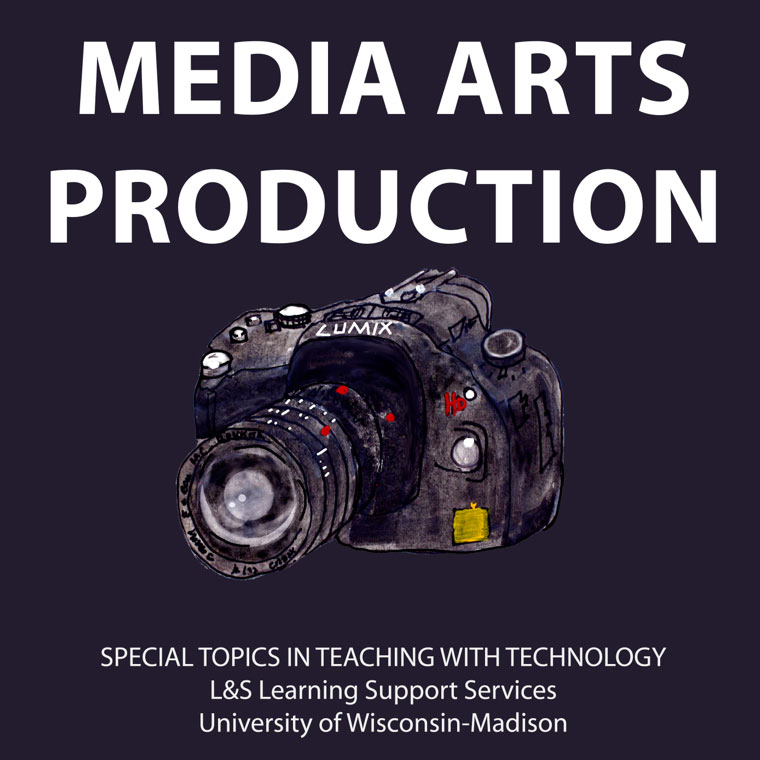L&S
Learning
Support
Services
presents
TEACHING with TECHNOLOGY
ONLINE WORKSHOP SERIES | 2012-2013
Overview of Media Arts Production

Thank you for participating in the second session of the L&S Learning Support Services Teaching with Technology Online Workshop Series. If you're not exactly sure what to expect from an online production course--or moreover, you're not sure about the term media arts--then you're in exactly the right place at precisely the right time.
Why Media Arts?
Media Arts is a broad & integrated creative discipline under which there are many modes of expression, all unified by the digital revolution. In some ways, computer arts provides a description which feels more concrete, one which my mother-in-law would find more helpful. I imagine she'd ultimately refine it to "something to do with the computer."
In higher education, multimedia or digital media are fairly common terms but are oddly disconnected from human mediated processes, as if to suggest that they are products that are born inside the computer without any intervention from human hands. At the end of the day, I think it's fair to say that these terms are evolving with the technology. And even though media arts production still feels a little vague, I rather prefer it to multimedia production. However, you'll see and hear both terms used interchangeably. Other terms that we'll use to describe the end product will include designed video and multimedia asset.
Another way to put it:
Session Goals
One of the goals of this session is to elevate media arts production in the practice and discourse of instruction. After all, the world of instruction as it is now (and as it will be) is inextricably fused with multimedia. At the same time, I get the impression that instructors perceive instructional multimedia as either outdated, embodied by memories of instructional films playing in dark classrooms, or on the other end of the spectrum as relevant, but not part of the real content. Both of these viewpoints are out of touch with reality. Gone are the days when a team of assistants allowed faculty to focus exclusively on research and teaching. And gone are the days when the only avenue to create or to distribute content was in the hands of producers, directors, and broadcasters. Like it or not, all of those roles are now "you."
Course Design
Where to begin? Certainly we expect that there should be an inherent realism, simplicity, and directness to learning about media arts production. After all, despite the impression that we can do it all, it's ridiculous to believe that we can master every new fancy technology. Sometimes, however, it's enough to know how to talk shop with a musician, illustrator, photographer, animator, 3D designer, printmaker, videographer, director, sound engineer, etc., etc. The best way to feel the discipline is to work within it. We've designed tutorials and projects that touch upon fundamentals, are inherently useful, and hopefully add an enjoyable pursuit to your semester.
Overview of Projects
There are two projects assigned during the module and several hands on tutorials. You may choose to do any or all of the projects. You should feel free to begin any or all of the projects and complete as much or as little as you have time for. While you will see the greatest benefit from completing all of the work, there's certainly a benefit from observing the process as it unfolds.
The first is photography assignment. The second project called "the short mundane presentation" covers the workflow needed to record and edit a traditional PowerPoint Presentation. The tutorials provide enough depth for you to modify as you see fit.
The tutorials are termed design guides that walk through fundamental concepts in use, and cover the workflow with given sets of software. The second and final project has exercise files that can be downloaded so that you can work through a tutorial within a specific set of software. For the most part the module uses Apple hardware and software on both the desktop and mobile platforms.
Materials
Nearly all of the multimedia materials used in the workshop series were created specifically for the workshop. We approached production so that resources we used exemplify what's available in and around campus. In this way of working, each thing is a discussion about the process of making instructional multimedia. At several spots in the module we've included production notes about the design and creation workflow.
Tips
One challenge of any creative endeavor is persevering through the difficulties long enough to realize a breakthrough. Sometimes using technology can help us get to where we want to go, but at other times it can be an obstacle. The tutorials and projects in this module are designed for beginners, but they do require general proficiency using a computer, including the ability to navigate the web, and locate files within the folders of your individual machine. More than anything, when working with technology, it's helpful to adopt a flexible and resourceful mindset, and to jump right in! So let's go!!